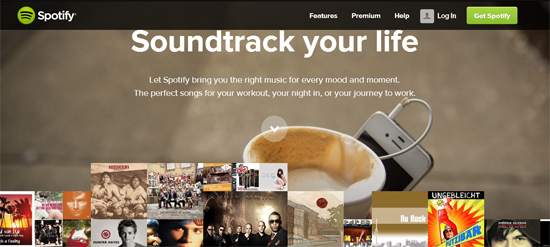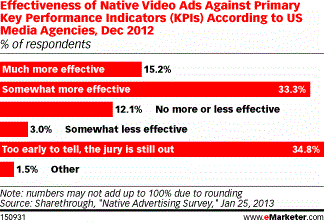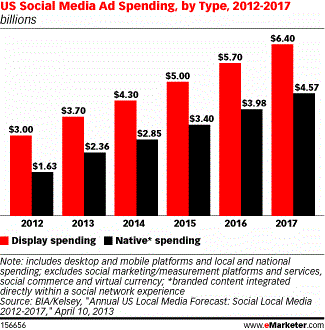Native advertising.
It’s the latest craze.
I can’t go anywhere without hearing people talking, tweeting or blogging about it. There’s even an annual Native Advertising Summit dedicated to it.
While the definition varies depending on who you talk to, native advertising is simply advertising designed for a digital media channel, in terms of content and format, that doesn’t interrupt our experience as users and customers.
Simplified?
It’s branded sponsorship. Or digital ads we enjoy.
Sponsored Editorials. Promoted Tweets. Facebook’s Sponsored Stories. Paid Discovery on StumbleUpon. Promoted Videos on YouTube. Sponsored Blog Posts. FourSquare Promoted Updates…
These are all forms of native advertising. But what’s missing from the conversation isn’t what it is or best practises – it’s one big decision. Should small businesses use native advertising? More importantly, should you?
We’re going to figure out if native advertising for small businesses makes sense. Here are 5 questions that will help you make the right decision for your business.
p.s. Want to know more about native advertising? Mashable does a basic overview and KISSmetrics goes into more detail. You can also check out this infographic, which visually explains everything you need to know.
1. Do you do Content Marketing?
Are you doing content marketing?
If so, native advertising is something you might want to consider.
Native advertising is simply another form of content – the only difference is that in addition to creating the content, you’re paying someone to showcase it. All the challenges of creating and curating content that you’re already doing apply.
Except…
The golden rule for content marketing – reuse your content again and again. While you can repurpose content for native advertising, it’s more challenging.
Native advertising works because each piece of content is curated for a specific channel. While you may have a similar message to share across platforms, you’ll convey it differently through a Promoted Tweet than a Facebook Sponsored Story or an advertorial. And you’ll interact with your customers differently using those channels – this is what serial entrepreneur Gary Vaynerchuk calls “the native tongue of the platform.”
This means you’ll need more time and resources during the creation, distribution and monitoring process. Harvard Business Review talks about this additional challenge we face with native advertising.
If you do native advertising, it should fit with your content marketing strategy.
Don’t have one?
Content marketing is a great way to grow your business – many small businesses have used it to create multimillion dollar companies. One of the easiest ways to create content on a regular basis for small business owners is blogging. So why not check out The Practical Guide To Creating A Blogging Strategy That Actually Works and get started?
If you don’t do inbound marketing, you may want to hold off on native advertising.
After all, it’s just one more way to drive traffic to your website. While that sounds like a good idea, if you don’t have an inbound marketing strategy to capture those leads and build relationships with them over time, it’s a wasted effort because native advertising is a long term game – it’s not a quick way to sell more products or services.
2. Do you use banner ads?
While we’re big believers in content marketing, we know many small businesses also use paid advertising (like Google Adwords and other ad platforms) to grow.
If you’re one of them, native advertising might be the next logical step.
The effectiveness of banner ads has been declining steadily. The average click through rate (how often someone sees an ad and clicks on it) dropped from 9% in 2000 to a 0.2% in 2012. This means that less people are seeing your ad and taking action.
Native advertising could be the solution.
Sharethrough recently partnered with IPG Media Lab to do a study on the effectiveness of native advertising compared to banner ads. They discovered the following:
- We look at native ads 53% more than traditional displays.
- We are 18% more likely to buy from someone after seeing a native ad than a banner ad.
- We are 13% more likely to share a native ad compared to a regular digital one.
Native advertising seems like a more effective form of paid advertising on the web. So if you’re already doing paid online advertising, why not give it a go?
But before you do, check out this article from AdAdge on Why Bad Native Advertising Is Worse Than Banner Ads and Lucia’s article on Does Native Advertising Work on Adweek.
3. What’s your budget?
AT&T does a fantastic job using native advertising with their Spotify partnership.
Spotify is a digital music service that gives you access to millions of songs. AT&T sponsors a feature on Spotify called Surround Sounds, which lets your phone “listen” to a song that’s being played around you and then you tell where the song was recorded and performed.
I love this idea because it’s fully integrated with the platform. It’s a seamless experience.
But…
How much do you think it cost AT&T? While I can’t find out (if you have an idea, share it with us in the comments below), I gather it’s more than the average entrepreneur reading this blog spends on one marketing activity.
Since most small businesses budget roughly $2,500 for their annual marketing needs, native advertising doesn’t seem to be the best use of that capital. While native advertising content exists on other digital platforms, and hence can drive awareness and traffic, you need enough content on your site (and an inbound marketing funnel that converts customers) to make it worthwhile.
This takes time. And resources.
Furthermore, like most advertising, repetition is key. While one advertorial or promoted tweet might work, you’ll want to do more to maximize your returns (this is why Target is partnering with BuzzFeed to do a series of native editorials targeting pet owners, not just one). And repetition consumes resources.
Do you just want to drive more traffic to your blog without paying for it?
Here are 10 obvious things you can do to increase your readership that you might not be doing.
4. Are you a voyager?
You’re an entrepreneur.
But how much do you like to gamble?
Native advertising is new. There are no industry benchmarks to base your plan on, or see how you’re doing compared to other small businesses. And while you can figure out what works using a trial and error method (which you do with any marketing campaign), that eats up valuable resources.
Plus, it’s hard to know (despite early tests) what kind of results you can expect. As you’ll see below, eMarketer discovered that while 15% of marketers believe native advertising works, and 33% are leaning towards it, for many it’s too early to be certain.
Why not let other companies make the expensive mistakes and learn from them when more best practices have been established?
But…
As always, some of us will pave the way. If you experiment with native advertising, drop me a line and let me know how it goes. We’re always looking to showcase examples of small businesses who are having success with online marketing.
5. Do you like free press?
I know.
What a stupid question.
But hear me out.
Publishers are becoming obsessed with native advertising because it’s another way to generate revenues. This is why everyone from Forbes and The New York Times to Gawker and Mashable are jumping on board. They want us to use it. And they’re doing a good job. As you can see from the chart below, marketers are shifting more of their budgets from banner ads to native advertising.
But why not call up some editorials and get free press?
I love free press.
As a small business owner, I don’t believe you should have to sponsor an article to get your story out. Most entrepreneurs I know have so much to share – indeed this is why inbound marketing is ideal for small businesses. So find the heart of your story and reach out to someone who’s willing to tell it. For free.
Target may not get free press for their pet products, but you can.
And remember, “press” isn’t what it was 5 or even 10 years ago. It’s not about getting on the front page of the paper anymore. It’s about finding communities where your fans are and engaging with them.
The founders of BaseCamp are notorious for this. They say while an article in The Globe & Mail or The New York Times is great for your ego (and to share with your friends and family showing that “you’ve made it”), they get more customers and partners from industry specific publications and online communities.
Think of press as digital outreach or social pr. If you focus on building relationships with other experts, communities and publications in your industry, that investment will have lasting impact, just like inbound marketing.
p.s. Need some tips on how to get free press? Check this out.
Conclusion: Native Advertising For Small Businesses?
Just like when we discussed if Vine is right for your small business, don’t jump on the latest trend because we’re all talking about it.
What will set you apart from your competition is executing on a marketing strategy over time. And while it’s important to adapt based on results (and yes, industry trends), make sure you stay focused on your goals.
And keep executing.
So, are you a fan of native advertising for small businesses? How are you seeing small businesses use it?




